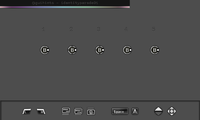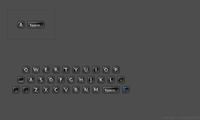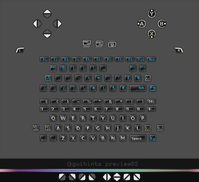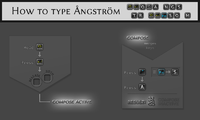I probably shouldn't comment (although I have attempted to follow the conversation of this thread as it has progressed along) but I do like the idea of what you are aiming for with
guihints (if I have understood it correctly? See attempted explanation below).
The gist?
In that you are wishing to one day, have a nice overlay explanation of any given games/apps controls, callable via an ingame button press, that will clear up any confusion that abounds, from the open nature of the many devs making control schemes of their own choosing, rather than following an arbritary standard that would limit the creativity of individual coders.
Your aim being, to have this as a user added addition to any PND manually, or perhaps the dev's themselves integrating your gui hints code into their PND package and then quickly taking the time to add their own apps control scheme, via some nice and intuitive interface for the PND packager to make this a pleasure, rather than chore, to add to their intended PNDs release.
The result would be that any PND whose maker has added gui hint functionality (or if manually added by the end user, akin to OVR editing perhaps(?)), would feature the ability for the end user, to quickly call up a reference overlay of controls, in case they haven't used it recently, or bothered to read any included read me documentation (sometimes unhelpfully generically called just 'read me' in the documentation section of the menu) on a first run of said PND.
Overall : eliminating the experiences of launching either a new, or long since forgotten PND and then playing the "hit every key and control set on the Pandora in order to either progress within the menu, achieve something as intended, or just plain quit the PND in question without calling up the killmanager via the Pandora button, or a soft - reset, when even that fails to do anything" game. Which is a form of Pandora Yoga that (whilst no doubt therapeutic for the fingers and the mind in some way) isn't so welcome, when you just want to get something done.
Therefore, as I said above I commend what your upto and I hope you can bring it to a level you are happy to release as at least a beta of your concept for people to provide you with 'working' within a PND feedback as to its usefullness.
At this point though, I need to comment upon the picture you have just provided.
I like very much the artwork for the buttons displayed in a row along the bottom of the picture. The shoulders, start, select, space, keyboard A button are very clear. The dpad indications are less clear and I prefer the first example due to its size and the lack of the + plus symbol in the middle which detracts from the arrows indications. I think a simple set of a single arrows 8 way directions would be ample to follow, or if indicating game moves such as down, down right, right + punch, the images could be shown in much the same way, as is common for game manuals/arcade cabs using your current graphics. Alternatively return to a standard D pad crossbar from earlier examples you gave and simply colour the directions required.
Of the 5 examples of the
B button you have posted for comment upon though, I would choose 3 personally. This is the clearest when scaled down to the Pandora size in that the contrast of the white ring and black areas is clearest at a glance.
Yet I have responded at moderate length, in order to actually understand what I am looking at in relation to the
'B' button, even at a glance or prolonged look.
No offence is meant here either but I simply don't 'get' what is attempted to be conveyed by these examples of
B buttons.
I understand the cardinal points around the B button, as much as a Christian 'gets' the Halo and overlayed Crucifix around a rennaisance image of Christ i.e not at all.
What is the ring around the button for?
What are the N, E, S, W markers for?
What is the White Dot for?
You have said "
The attached image contains 5 variations of the latest action button hints with added button_offs (visual clues to the action buttons that an action button hint is not referencing). which in and of itself, I find a confusing explanation.
What is a button_off?
What is a 'visual clue' (if not a hint) to a button, that is a button whose hint, is not referencing itself to be the button in question?
Benjamin Button and Mr Spoon perving ladies from Button Moon makes more sense at this point
 Imhho you should make a set of icons that depict the Pandora buttons and nubs with L R imposed over them and release some beta form of gui hints, so that people can explore how it will integrate with their PNDs or be able to be added in by end users, to see where this can progress to.
Its a stunning idea and it could help the overall operability of Pandora along nicely, making it far more user friendly which is pure win. So I hope you get it all sorted out to your satisfaction and that it gets integrated in some form into the Pandora library when your ready.
Imhho you should make a set of icons that depict the Pandora buttons and nubs with L R imposed over them and release some beta form of gui hints, so that people can explore how it will integrate with their PNDs or be able to be added in by end users, to see where this can progress to.
Its a stunning idea and it could help the overall operability of Pandora along nicely, making it far more user friendly which is pure win. So I hope you get it all sorted out to your satisfaction and that it gets integrated in some form into the Pandora library when your ready. 






